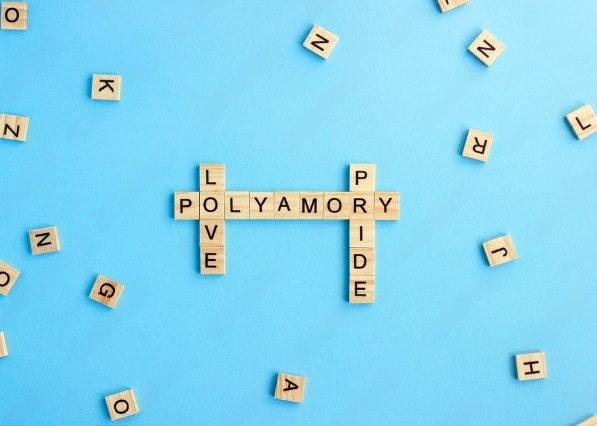Polyamory is getting more and more buzz these days. But, what does is mean to be polyamorous? When it comes to relationships, polyamory is a style that comes from the philosophy that one person doesn’t need to be your everything.
After all, putting all of your sexual, romantic, and emotional needs and desires in the hands of one person can be a lot of pressure. It’s like when your boss adds more responsibilities to your job. Not every millennial is a social media manager, Susan.
While monogamy is still the societal standard, more people are trying out this type of relationship style. In fact, a 2021 study found that one in nine people engaged in polyamory at some point during their life. Here’s a look at what a polyamorous relationship can look like, and how it works.
What Is Polyamory?
“Polyamory is the act of having multiple intimate, romantic and/or loving relationships with the knowledge and consent of all parties involved,” says Saba Harouni Lurie, licensed therapist and owner of Take Root Therapy.
A polyamorous person is open to romantic or sexual connections with more than one partner. The term polyamory comes from the Greek “poly,” meaning multiple, and the Latin “amor,” meaning love. It is often shortened to “polyam” or “poly.”
How Do Polyamorous Relationships Work?
“There are as many options for designing a poly relationship as there are possible combinations of people. Any variation is possible,” says Dr. Timaree Schmit, sexuality educator.
The more people involved in a relationship, the more connections are created in all different shapes. If two people each have two partners, and they each have two partners, and so on, that’s a ton of people connected in numbers we didn’t study enough math to calculate. Is that factorial, exponential, or extraterrestrial? We lost our class notes.
Once you start connecting those dots, the shape of your relationships will start to form. And, it may be just as messy and unrecognizable as the connect-the-dot drawings you did in kindergarten. There are some labels that describe different types of polyamory, but ultimately, you decide how your relationships work and what labels work for you.
Types of Polyamorous Relationships
- Polycule: A portmanteau of “polyamory” and “molecule,” the term polycule describes the unique network of polyamorous people connected through their relationships
- Vee: A relationship where one person is dating two people, but those two people aren’t dating each other, creating a v-shaped connection.
- Triad: Also known as a throuple, a triad is a relationship between three partners who are all romantically or sexually connected with each other.
- Quad: A relationship between four partners who are romantically and sexually connected with each other. Like a triad, but four. See, math isn’t that hard!
Styles of Polyamorous Relationships
- Hierarchical Polyamory: The practice of polyamory that places more importance on some connections than others. For example, a couple that lives together may prioritize their nesting or primary partner over connections that don’t live in the household.
- Non-hierarchical Polyamory: The practice of polyamory that does not prioritize any specific members of the relationship over the others. Each connection is unique, but not treated as more or less important.
- Relationship Anarchy: The philosophy of rejecting societal hierarchies of relationships, especially those that prioritize romance over friendship or confine intimacy to sexual relationships.
- Solo Polyamory: Also known as sopo, solo polyamory is when a polyamorist prioritizes their own needs and dates independently.
- Kitchen Table Polyamory: A style that focuses on communal support for everyone involved and connections between metamours. The concept is everyone could dinner at the kitchen table with little to no awkwardness. Even if you need to bust out the folding chairs.
Is Polyamory Just Cheating?
“Polyamory is not considered cheating because there is no deceit,” says Harouni Lurie. “Everyone involved should be given the opportunity to consent to the relationship dynamic and have full knowledge of the other person or people.”
Polyamory is a type of ethical or consensual non-monogamy. Ethical non-monogamy (ENM) is an umbrella term for the practice of having romantic or sexual relationships that are not exclusive between two people, with the consent of everyone involved. Cheating is unethical non-monogamy where nobody consented to being on a break, Ross.
“Cheating is about breaking agreements, not about the design of the relationship. You can cheat in an open relationship if you do something you agreed not to do,” says Dr. Schmidt. “What counts as cheating entirely depends on the people in the relationship. Even within monogamous culture, there is stark disagreement about what ‘counts’ because we have different needs and thresholds.”
Cheating is defined by the agreements in your relationship. If you violated those agreements, it could be considered cheating.
Some polyamorous relationships are closed. This means that the relationship involves more than one person, but those people do not date outside of that relationship. Some polyamorous relationships have boundaries on who or how their partners can date.
Polyamory vs. Open Relationships
An open relationship is a relationship that is open to outside sexual partners. Polyamorous relationships are kind of like open relationships, but not all open relationships are polyamorous.
“Polyamory is an example of an open relationship. Other options might include swinging, where a committed couple just has sex with others, but are not necessarily getting romantically involved. You can have agreements about being able to hook up with others in specific contexts, like when you’re traveling. The only limit is your imagination and the desires and needs of the people involved,” says Dr. Schmidt.
If your relationship is polyamorous but closed, there are multiple romantic partners in the relationship, but they are not open to new sexual connections. That relationship style is called polyfidelity.
If your relationship is open but not polyamorous, your relationship is open to new sexual connections, but not long-term romantic connections.
Should You Consider Polyamory?
“If someone is curious enough to ask themselves if polyamory is right for them, then it’s likely worth exploring. We’ve all been taught these hard and fast rules about relationships, including that monogamy is the only way,” says Harouni Lurie.
“Polyamory is certainly not for everyone either, but if you have a more challenging time in conventional monogamous relationships and feel pulled toward multiple connections, it might be worthwhile to consider polyamory.”
Like with any interpersonal relationship, you’ll face challenges and conflicts. You can date as many people as you can share your Google calendar with, but you still only have 24 hours in a day to manage dates, quality time, and snuggle appointments. You’ll need time management skills to be a good partner in multiple relationships.
But most importantly, you need to know what you want in a relationship and to communicate that honestly with your partners.
“[Polyamorous] relationships require a lot of compassionate, considerate, and direct communication.
Because we are conditioned to believe that monogamy is somehow ‘right’ and other relationship dynamics are wrong, even when everyone is willingly participating in polyamory, it can be hard to suppress that programming which tells us that we should feel jealous or hurt if our partner is involved with another person,” says Harouni Lurie. “If and when those emotions arise in a poly relationship, it is important that all parties communicate about how they’re feeling.”
- How To Measure Your Bra Size At Home, Plus A Helpful Chart - October 12, 2023
- 7 LGBTQ+ Dating Apps That’ll Actually Get You A Match You Want - July 14, 2023
- 50 Funny Dating App Openers Guaranteed to Get You a Response - July 6, 2023

















Leave a Comment